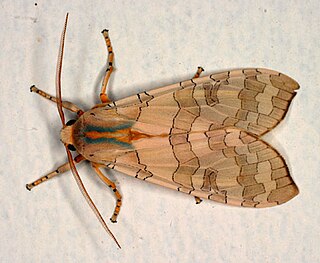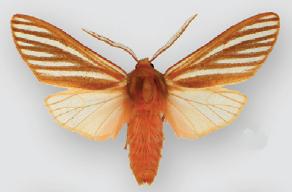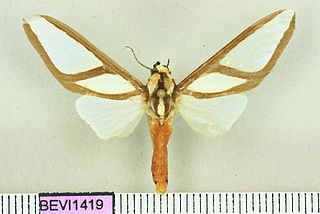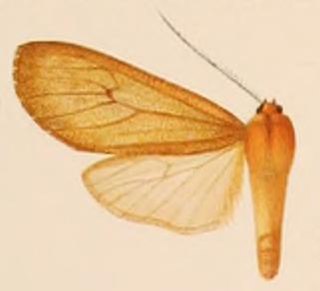
The Phaegopterina are a subtribe of tiger moths in the tribe Arctiini, which is part of the family Erebidae. The subtribe was described by William Forsell Kirby in 1892.

Agaraea is a genus of tiger moths in the family Erebidae. The genus was erected by Gottlieb August Wilhelm Herrich-Schäffer in 1855.

Amastus is a genus of moths in the family Erebidae. The genus was erected by Francis Walker in 1855.

Phragmatobia is a genus of moths in the subfamily Arctiinae described by Stephens in 1828. Many tiger-moth species of small and medium size were described within this genus. However, only a few are related to the type species.
Zatrephes is a genus of moths in the family Erebidae. The genus was erected by Jacob Hübner in 1819. It was formerly considered part of the Arctiidae. It includes the former genus Ennomomima, which is now considered a synonym.

Pseudohemihyalea is a genus of moths in the family Erebidae described by Régo Barros in 1956. While the caterpillars of most species of Pseudohemihyalea feed on broad-leaved trees, the P. ambigua group has larvae that feed on conifers. Their forewing coloration has accordingly evolved to light-and-dark lengthwise striping, giving better camouflage among the slim needles of the host plants. In this, they seem to be convergent to certain geometer moths, such as Caripeta piniata or Sabulodes niveostriata.

Robinsonia is a genus of moths in the family Erebidae. The genus was erected by Augustus Radcliffe Grote in 1866.

Xylophanes is a genus of moths in the family Sphingidae erected by Jacob Hübner in 1819. As of 2000, there are about 96 species and subspecies included in the genus.

Arsenura is a genus of moths in the family Saturniidae. The genus was erected by James Duncan and John O. Westwood in 1841.

Amastus rufocinnamomea is a moth of the family Erebidae first described by Walter Rothschild in 1909. It is found in Peru.

Amastus muscosa is a moth of the subfamily Arctiinae first described by Walter Rothschild in 1909. It is found in Peru.
Agaraea mossi is a moth of the family Erebidae. It was described by Walter Rothschild in 1922. It is found in Peru.
Arctiarpia mossi is a moth of the subfamily Arctiinae first described by Walter Rothschild in 1922. It is found in Guyana, French Guiana, Peru and Amazonas.
Amastus cellularis is a moth of the family Erebidae. It was described by Walter Rothschild in 1922. It is found in Peru.
Amastus walkeri is a moth of the family Erebidae. It was described by Walter Rothschild in 1922. It is found in Peru.
Opharus lehmanni is a moth of the family Erebidae. It was described by Walter Rothschild in 1910. It is found in Colombia.
Amastus modesta is a moth in the family Erebidae. It was described by Peter Maassen in 1890. It is found in Bolivia.
Robinsonia mossi is a moth in the family Erebidae. It was described by Walter Rothschild in 1922. It is found in French Guiana and Brazil.
Zatrephes mossi is a moth in the family Erebidae. It was described by Walter Rothschild in 1933. It is found in Brazil.
Cotana is a genus of moths in the family Eupterotidae.







